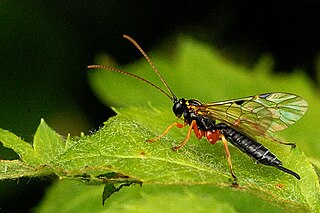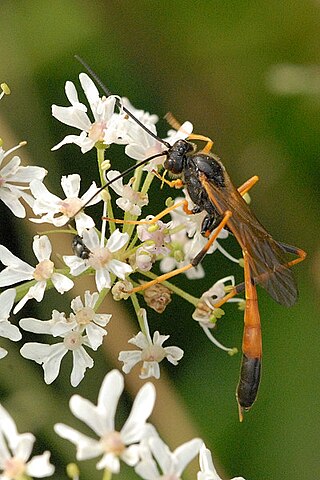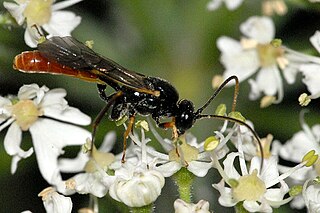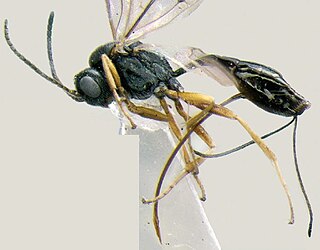
The superfamily Ichneumonoidea contains one extinct and three extant families, including the two largest families within Hymenoptera: Ichneumonidae and Braconidae. The group is thought to contain as many as 100,000 species, many of which have not yet been described. Like other parasitoid wasps, they were long placed in the "Parasitica", variously considered as an infraorder or an unranked clade, now known to be paraphyletic.

The Ichneumonidae, also known as ichneumon wasps, ichneumonid wasps, ichneumonids, or Darwin wasps, are a family of parasitoid wasps of the insect order Hymenoptera. They are one of the most diverse groups within the Hymenoptera with roughly 25,000 species described as of 2016. However, this likely represents less than a quarter of their true richness as reliable estimates are lacking, along with much of the most basic knowledge about their ecology, distribution, and evolution. It is estimated that there are more species in this family than there are species of birds and mammals combined. Ichneumonid wasps, with very few exceptions, attack the immature stages of holometabolous insects and spiders, eventually killing their hosts. They play an important role as regulators of insect populations, both in natural and semi-natural systems, making them promising agents for biological control.

The Braconidae are a family of parasitoid wasps. After the closely related Ichneumonidae, braconids make up the second-largest family in the order Hymenoptera, with about 17,000 recognized species and many thousands more undescribed. One analysis estimated a total between 30,000 and 50,000, and another provided a narrower estimate between 42,000 and 43,000 species.

Megarhyssa, also known as giant ichneumonid wasps, giant ichneumons, or stump stabbers, is a genus of large ichneumon wasps, with some species known for having the longest ovipositors of any insects. They are idiobiont endoparasitoids of the larvae of wood-boring horntail wasps. The ovipositor can be mistaken for a large stinger. This is a genus of holometabolous insects within subfamily Rhyssinae that includes 37 species and belongs to Ichneumonidae, the family of wasps with the highest biodiversity in the world.

Banchinae is a subfamily of ichneumonid parasitoid wasps containing about 1,500 species; the genera Glypta and Lissonota are very large. The three tribes are all distributed worldwide.

Ophioninae is a worldwide subfamily of Ichneumonidae, comprising 32 genera and exhibiting high diversity in tropical regions. They are koinobiont endoparasitoids of larval Lepidoptera, although at least one species parasitizes Scarabaeidae (Coleoptera). Notably, they are among the few species within Parasitica whose ovipositors are capable of stinging vertebrates. Pupae of Ophioninae are ovoid and feature a distinct central clear band, which is a characteristic trait of this subfamily. These insects are typically large, slender, and orange, with compressed and curved abdomens. They possess prominent ocelli and are primarily active during the night, often being attracted to light sources.

Ctenopelmatinae is a cosmopolitan subfamily of ichneumonid parasitoid wasps.

Pimplinae are a worldwide subfamily of the parasitic wasp family Ichneumonidae.

Acaenitinae is a subfamily of the parasitoid wasp family Ichneumonidae. Female Acaenitinae have a large triangular projecting genital plate.

Anomaloninae is a subfamily of parasitoid wasps in the family Ichneumonidae. Several species provide beneficial services to humans by attacking forest or orchard pests.

The Tryphoninae comprise a worldwide subfamily of the parasitic wasp family Ichneumonidae.

Ichneumoninae is a worldwide subfamily of the parasitic wasp family Ichneumonidae.

Campopleginae is a large subfamily of the parasitoid wasp family Ichneumonidae with a world-wide distribution. Species in this subfamily have been used in the biological control of the alfalfa weevil, clover weevil, various species of Heliothis, oriental army worm, European corn borer, larch sawfly, and others.

Mesochorinae is a worldwide subfamily of the parasitic wasp family Ichneumonidae.

Cremastinae is a worldwide subfamily of the parasitic wasp family Ichneumonidae.

Tersilochinae is a worldwide subfamily of the parasitic wasp family Ichneumonidae.

Rhyssa persuasoria, also known as the sabre wasp, is a species belonging to the family Ichneumonidae subfamily Rhyssinae. Members of this subfamily, including those of Rhyssa and the allied Megarhyssa, are also known collectively as giant ichneumonid wasps or giant ichneumons.

Amblyteles armatorius is a species of parasitic wasp in the family Ichneumonidae first described by Johann Reinhold Forster in 1771.

Megarhyssa macrurus, also known as the long-tailed giant ichneumonid wasp or long-tailed giant ichneumon wasp, is a species of large ichneumon wasp. It is a parasitoid, notable for its extremely long ovipositor which it uses to deposit an egg into a tunnel in dead wood bored by its host, the larva of a similarly large species of horntail.

Pimpla rufipes, the black slip wasp, is a species of wasp belonging to the family Ichneumonidae. It is distributed across Europe, Asia, and northern Africa.



















